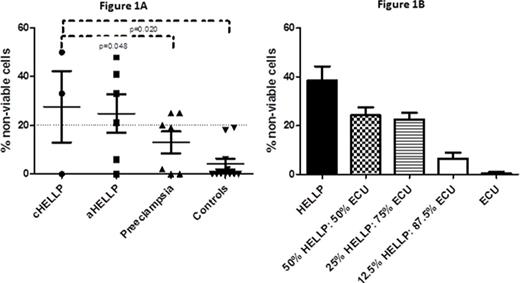Abstract
Introduction: HELLP syndrome (hemolysis, elevated liver enzymes, and low platelets) is a severe variant of preeclampsia that leads to severe morbidity and mortality to both the mother and fetus. Delivery is the treatment of choice at or beyond 34 weeks, but there are no good therapies for pregnant women with HELLP before 34 weeks of pregnancy. Although there are no strict criteria for its diagnosis, the Tennessee and Mississippi classifications have been proposed using platelet count (<100,000 or 150,000 cells/microL), lactate dehydrogenase levels (LDH>600 IU/L), bilirubin (>1.2 mg/dL) and aspartate aminotransferase (AST) with or without alanine aminotransferase (ALT) levels (AST >40 or 70 IU/L, ALT>40 IU/L). However, LDH, AST and bilirubin are not specific for liver dysfunction and their elevation may be caused by intravascular hemolysis alone. Recent evidence and clinical similarities suggest a link to atypical hemolytic uremic syndrome (aHUS), a disease of excessive alternative complement pathway (APC) activation. To test this hypothesis we utilized a functional complement assay, the modified Ham test recently described for aHUS diagnosis.
Method: Women with classic HELLP, atypical HELLP, preeclampsia with severe features, and women with normal pregnancies were recruited for the study from September 1, 2014 to May 31, 2015. Women with known sickle cell disease, systemic lupus erythematous, antiphospholipid antibody syndrome, or previous diagnosed microangiopathic and hemolytic diseases were excluded. All participants were greater than 23 weeks pregnant. Classic HELLP syndrome was defined as satisfying all Mississippi or Tennessee criteria for HELLP syndrome; while atypical HELLP as having at least one laboratory abnormality in the Mississippi or Tennessee criteria. Sera was collected and sent blinded to the laboratory. APC activation was detected in the modified Ham test and compared to previously described marker of complement activation, serum C5b-9 levels. Furthermore, we tested the in vitro ability of eculizumab to inhibit APC activation. Eculizumab containing serum was collected from a patient with paroxysmal nocturnal hemoglobinuria (PNH) within 60 minutes after the infusion.
Results: Serum from 9 women with classic or atypical HELLP, 7 women with severe preeclampsia, and 11 controls (healthy pregnancy) were tested. We found no significant difference in serum C5b-9 levels among patients with HELLP, preeclampsia and controls (p=0.808). However, increased complement activation in the modified Ham test, represented as significantly higher percentage of non-viable cells/cell killing (25.7±19.8% versus 4.1±7.3%, p=0.005), was found in participants with classic or atypical HELLP compared to participants with healthy pregnancy (Figure 1A). Participants with classic HELLP demonstrated significantly more cell killing when compared to severe preeclampsia (38.7+9.8% versus 13.0+11.7, p=0.048). In the ROC (receiver operating curve) analysis, a percentage of killing higher than 20.5% was determined as a cut-off value for the diagnosis of HELLP with 66.7% sensitivity and 88.9% specificity. Importantly, mixing sera from 4 HELLP patients with eculizumab containing serum in different percentages resulted in a significant decrease of cell killing compared to HELLP serum alone (Figure 1B, p=0.007).
Conclusions: We have shown that preeclampsia with severe features along with classic and atypical HELLP syndrome may be considered, at least in part, a disease of excessive complement activation. The modified Ham test is a serum-based assay that does not theoretically detect increased complement activation caused by mutations in cell membrane factors. Other pathophysiological mechanisms beyond complement activation may also account for the negative results in 3 HELLP participants. Importantly, the modified Ham test seems a promising tool to identify patients with increased complement activation who may benefit from complement inhibition. If confirmed in a larger cohort, this rapid, inexpensive and highly specific assay may be valuable to select patients for such a clinical trial.
Brodsky:Alexion Pharmaceuticals: Membership on an entity's Board of Directors or advisory committees.
Author notes
Asterisk with author names denotes non-ASH members.


This feature is available to Subscribers Only
Sign In or Create an Account Close Modal